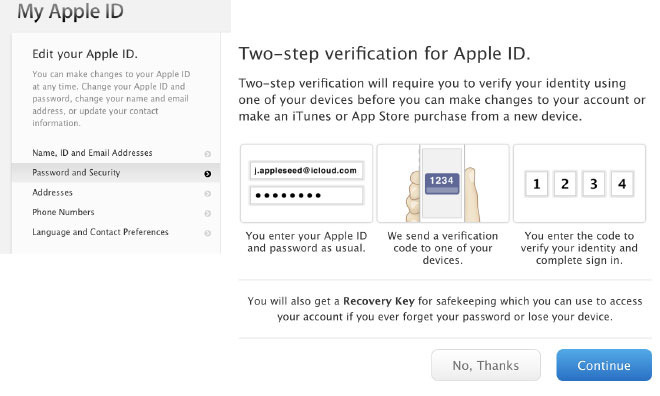Apple's SMS one-time passcode proposal moves forward with help from Google
Apple's effort to develop a standardized format for one-time passcodes sent through SMS messages is moving forward with the help of Google engineers, as the proposal this month garnered official status as a Web Platform Incubator Community Group (WICG) specification draft.

Apple previously relied on two-step verification for Apple ID before moving to a two-factor protocol.
Announced in an updated GitHub explainer, an initial report of Apple's "Origin-bound one-time codes delivered via SMS" project was published by the WICG on April 2. The draft was co-edited by Theresa O'Connor from Apple and Sam Goto from Google.
First proposed by Apple WebKit engineers and backed by Google in January, the initiative seeks to simplify the OTP SMS mechanism commonly used by websites, businesses and other entities to confirm login credentials as part of two-step authentication systems.
While many websites and online services use OTP over SMS, a standardized method of formatting incoming messages text does not exist. As such, "programmatic extraction of codes from [SMS messages] has to rely on heuristics, which are often unreliable and error-prone. Additionally, without a mechanism for associating such codes with specific websites, users might be tricked into providing the code to malicious sites," the WICG publication notes.
Currently, users must manually input provided passcodes into a text field on a host website. Apple wants to push the status quo with a more refined solution that would also provide a higher degree of security.
Using a "lightweight text format," the proposed format embeds an actionable one-time code in an SMS message and links that code to an originating URL. The recipient system can then extract the code and log in to an associated website automatically.
An example OTP SMS:
"This proposal attempts to reduce some of the risks associated with SMS delivery of one-time codes," the explainer reads. "It does not attempt to reduce or solve all of them. For instance, it doesn't solve the SMS delivery hijacking risk, but it does attempt to reduce the phishing risk."
Publication as a WICG specification draft does not necessarily mean Apple's protocol will see mass deployment, but it does show the project is moving forward.

Apple previously relied on two-step verification for Apple ID before moving to a two-factor protocol.
Announced in an updated GitHub explainer, an initial report of Apple's "Origin-bound one-time codes delivered via SMS" project was published by the WICG on April 2. The draft was co-edited by Theresa O'Connor from Apple and Sam Goto from Google.
First proposed by Apple WebKit engineers and backed by Google in January, the initiative seeks to simplify the OTP SMS mechanism commonly used by websites, businesses and other entities to confirm login credentials as part of two-step authentication systems.
While many websites and online services use OTP over SMS, a standardized method of formatting incoming messages text does not exist. As such, "programmatic extraction of codes from [SMS messages] has to rely on heuristics, which are often unreliable and error-prone. Additionally, without a mechanism for associating such codes with specific websites, users might be tricked into providing the code to malicious sites," the WICG publication notes.
Currently, users must manually input provided passcodes into a text field on a host website. Apple wants to push the status quo with a more refined solution that would also provide a higher degree of security.
Using a "lightweight text format," the proposed format embeds an actionable one-time code in an SMS message and links that code to an originating URL. The recipient system can then extract the code and log in to an associated website automatically.
An example OTP SMS:
ZDNet reported on the WICG development on Tuesday.
"This proposal attempts to reduce some of the risks associated with SMS delivery of one-time codes," the explainer reads. "It does not attempt to reduce or solve all of them. For instance, it doesn't solve the SMS delivery hijacking risk, but it does attempt to reduce the phishing risk."
Publication as a WICG specification draft does not necessarily mean Apple's protocol will see mass deployment, but it does show the project is moving forward.

Comments
Making OTP over SMS more convenient doesn’t solve the underlying problem. SMS needs to be replaced with a new standard, rather than putting lipstick on a pig.
It's only accessible if the phone is unlocked, and if it's unlocked, all bets are off anyway, aren't they?
Wait until you find out Google and Apple are working together on making smart devices in your home more secure and at the same time easier to use. Might be a good time to start getting over your phobia unless you plan to stop using your iPhone and all other smart devices in the relatively near future.
Apple is working with Google on a whole lot of projects, from video streaming to cloud security, data sharing, and IoT security and software standards. It's that many of these things you just weren't aware of.
"It does not attempt to reduce or solve all of them. For instance, it doesn't solve the SMS delivery hijacking risk, but it does attempt to reduce the phishing risk."